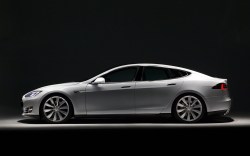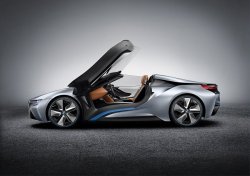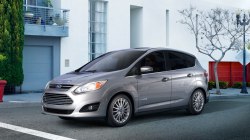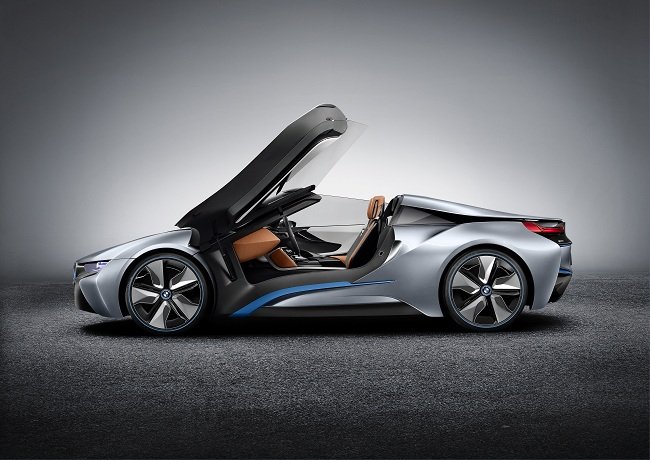
The Tesla Model S: Finally, an electric car that Nicolas Cage can drive through an explosion. (Photo by Tesla Automobiles.)
One night a few weeks ago, while on a Honda junket in Santa Barbara, I had dinner with a couple of Japanese green-car technology engineers. I realize that, in terms of cool cred, that statement ranks far below “I just got back from Burning Man” or “have you seen my TED talk?,” but I was still excited. I guess I’m a green-car nerd now.
After a weird moment where one of the engineers compared my beard to a bonsai tree, we began to discuss shop. I’ll admit that I didn’t understand everything they said to me, but here’s the gist: Honda puts its best engineers at work on developing alternative-fuel cars. And they’re not the only ones.
In the past year, as part of my strange new career as a car writer, I’ve driven everything from the most exalted Rolls-Royce to the lowly ScionIQ, and what pisses me off most about the cars I drive is their gas mileage. Why does that Infiniti only get 19 mpg, or that Mustang convertible 17 mpg? What’s with all these big, stupid crossover vehicles that cost 80 bucks a week to fill? Frankly, it’s pathetic.
I’m hoping that manufacturers might also be feeling the shame, and also pressure from their governments. Eventually, your average consumers might even start thinking alternative-fuel cars are cool, too. Look at the hoopla surrounding Tesla Motors’ recently released Model S “supercar.” It goes 3,000 miles per hour, approximately, and a recent Motor Trend test-drive in the desert showed it has an electric range of more than 250 miles. A change is coming. You should see these electric cars that BMW is putting out next year, the i3 and i8. They look like superhero cars from the future. I want one so bad.
While it would be wonderful if the entire world would just travel around on magnetized super-trains, the fact is, many people have to drive every day. Some of them have to drive quite far. So the way the car companies behave in the next 20 years will help determine the fate of our planet. I’m beginning to see encouraging signs.

BMW’s i8: Practical, but only if you’re going somewhere you won’t need roads. (Photo by BMW.)
For years, Honda’s been leasing out a hydrogen-fueled car for about $600 a month to discriminating California consumers. In a more mainstream gambit, the Honda Accord, a boring college-town sedan for decades, is about to appear in a plug-in hybrid version. The Honda FIT EV, though poorly available, gets more than 100 miles to a charge, and everyone I’ve talked to who’s driven it thinks it’s fantastic.
And Honda has to double-down on electric cars so it can catch up to Toyota. The Prius is one of America’s most popular cars, and Toyota’s adding more EVs to its fleet constantly, including a new plug-in Prius that gets a modest 12-15 miles per electrical charge. Toyota just introduced a hybrid Camry, which I drove and thought was pretty good, and an all-electric RAV4, which blew my mind when I drove it in July. I had it for five hours solid and there was still plenty of range left when I was done zipping it around Newport Beach.
Of course, Japanese and Korean automakers were working on this stuff back when we were chatting on AOL and enjoying the first season of Survivor. But now there’s also a little-reported alliance among General Motors, Chrysler, Ford, BMW, Mercedes, and the Volkswagen group. Their engineers are jointly developing alternative fuel technologies, which they must because Europe is adopting very rigid fuel standards in 2017. The U.S. will follow by 2025, assuming that it continues to elect federal executives that believe in the reality of global warming. The new U.S. CAFE standards (which unfortunately do not ban café-based spoken word nights — an initiative I also support) will bring the average mpg of cars up over 54, though it will probably be closer to 40 once all the evil oil lobbies munch their chunks off that. Regardless, it’s a big change from the current situation.
And now a confession: I try to enjoy combustion cars for what they are, especially if they go vroom really fast. People love them for a reason. They can be fast, fun, and often quite useful. But they have to change. I feel like, and I may be overly hopeful here, that I’m enjoying the last moments of a technology before it’s swept away by historical reality.

Ford C-Max: “Not everything can be an insectoid robot with lasers from 3030, OK? Some people just want more headroom!” (Photo by Ford.)
Of course, I also might be totally fooling myself. That awesome RAV4 I drove? Toyota’s only going to sell or lease 2,500 of them, and all in California. Same with Honda’s Fit EV. The Prius continues its unstoppable march toward segment dominance, but other alternative-fuel cars are struggling. The Chevy Volt, a fantastic car by any standard, is offering $259-a-month leases on cars that cost $40,000 last year. I haven’t driven the new Ford C-Max hybrid series, but everyone seems to love it a lot. Enthusiasm aside, the C-Max still warrants the usual “will people buy it?” caveat, an addendum phrase that seems to haunt the world of alternative-fuel cars. Consumers aren’t yet persuaded, except in rare West Coast pockets, and the infrastructure doesn’t yet exist to support alternative-energy cars en masse.
To those of you who still might be saying “the technology isn’t good enough yet,” I would say: You’re wrong. It’s definitely good enough. And to those who are reluctant because of price, fair enough. But the electric Model T, a car that will change the way the world drives, is coming. I don’t know what that model will be yet, or from what factory but regardless, this automotive Messiah will rise.
That said, even EV geniuses get the need for speed from time to time — and for that, burning carbon is still optimal. After a long dinner and much wine with my new engineer friends from Honda, one of them leaned in and said, “I have worked on every kind of fuel technology for cars,” he said. “And I am convinced that combustion engines work best.”
This surprised me, but he assured me that it was true. Though the world needs alternative-energy cars for its future survival, he said, racecars need to continue to run on gasoline. I agreed, for now. Watching electric cars race isn’t much fun — yet. That Model S goes pretty damn fast.



